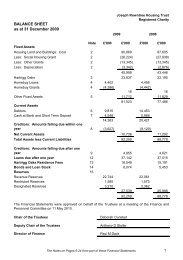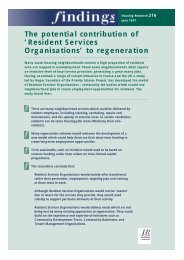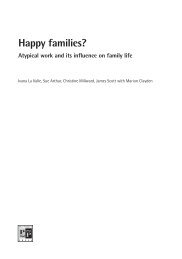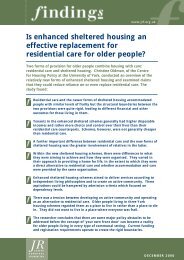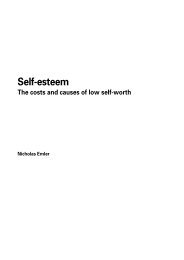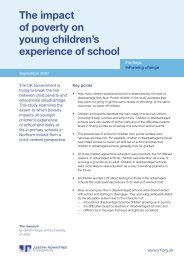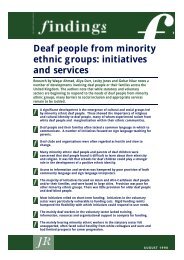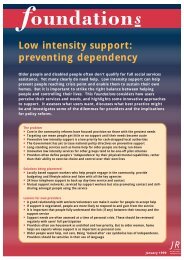Community participation - Joseph Rowntree Foundation
Community participation - Joseph Rowntree Foundation
Community participation - Joseph Rowntree Foundation
You also want an ePaper? Increase the reach of your titles
YUMPU automatically turns print PDFs into web optimized ePapers that Google loves.
Network dynamics: explaining the pattern<br />
Inequity<br />
Preferential attachment<br />
The social networks surrounding community <strong>participation</strong> structures in Ely and Benchill<br />
are characterised by a common signature: a few ‘nodes’ (e.g. people or institutions)<br />
have a very large number of connections to other nodes and a much larger number of<br />
nodes have only a few connections. We saw in the last chapter, for example, that Jim<br />
sat on the committee of the Tenants and Residents Association, the Communities First<br />
partnership and the Patient Reference Panel, while Brenda was a governor of two<br />
schools and sat on the board of the Wythenshawe Forum and the SRB partnership.<br />
It turns out that this pattern of a few nodes having a lot of links is a pervasive feature<br />
of contemporary social organisation not confined to community <strong>participation</strong>. 4<br />
A key idea in trying to explain this phenomenon is what has been termed ‘preferential<br />
attachment’. 5 Suppose that, every time a new node joined a network, it formed a link<br />
with an existing node at random. In that case, we would expect the distribution of<br />
links to be roughly even, some having a few more, some a few less, but no wild<br />
differences between the two. This is clearly not what has happened in Ely and<br />
Benchill. That’s because, in reality, networks don’t tend to work that way. A new node<br />
in the network is less likely to form a link at random than to try to link to a node that<br />
already has a number of connections, because that will be more useful.<br />
To illustrate, think about the strategies that airlines use when developing their routes.<br />
If you wanted to fly from, say, Exeter to Detroit, you would be unlikely to find an<br />
airline offering a direct flight. Instead, you might fly from Exeter to Paris, from Paris to<br />
Newark and from Newark to Detroit. This is what is known as a ‘hub and spoke’<br />
system – flights are routed from a cluster of smaller airports (e.g. Exeter) to a large<br />
central airport or ‘hub’ (e.g. Paris). From there, passengers take flights on common<br />
routes (‘spokes’) to other hub airports (e.g. Newark), from whence they can catch<br />
connecting flights to their final destination (e.g. Detroit). So, when an airline wants to<br />
start flying from a new airport, the best option will be to put on a route to an existing<br />
hub airport. That way, passengers from the new airport will be able to choose from<br />
the widest possible range of final destinations. In other words, rather than form a link<br />
at random, the new node in the network connects to a node that already has many<br />
other links. But, crucially, each time this happens, it makes it more likely that it will<br />
happen again in the future, because it adds yet another destination that passengers<br />
can reach by initially flying to the hub airport. In short, the more links a node in a<br />
network has, the more attractive it becomes to others, and the more likely it is to<br />
acquire new links as a result. This is the law of preferential attachment.<br />
37




